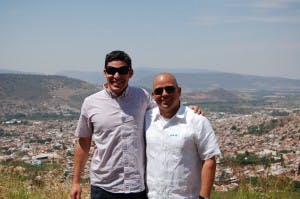For our last day in Guadalajara, Eric Rubin came down from San Francisco to show us the ropes. Eric, the man behind Tres Agaves tequila, is down in Mexico five or six times a year checking in on his agave. He might be from Tennessee, but he knows his stuff.
For dinner that Sunday night, Eric attempted to take us to his favorite Argentinian restaurant in Guadalajara but sadly, it was closed. Instead, we ended up at Cocina 88—a beautiful, colonial-looking restaurant that he told us is the go-to spot when the Cuervo big wigs take tequila folks out. By the end of the night, around 11, rain had started coming down in sheets, accompanied by thunder and lightening. There’s nothing more amazing than a warm, stormy night, so for a while we sat in the open-aired empty restaurant just watching the rain come down, inhaling that glorious fresh-rain smell.
Restaurant industry people have no issue eating two dinners in one night. Especially when it’s in the name of R&D. So on the way back, we stopped at Karne Garibaldi, a restaurant famous for serving one dish and one dish only: carne en su jugo, a comforting, soupy mess of beef, bacon and beans, served up with grilled onions, potatoes, tortillas and salsa. It’s the kind of food you eat with unreserved gusto. It’s the kind of food you eat when you’re drunk.
The next day, we hired a driver named Alex to drive us out to the highlands. (Should you ever need a driver in Guadalajara—dependable, knowledgeable and reasonably priced—he’s your guy: Email him at alexhinojosa@hotmail.com). He brought us up to visit the 7 Leguas tequila distillery. The drive up to the highlands is quietly beautiful. It starts to get hilly and rolling, church steeples poking up here and there. As Joe said, it’s like a Mexican Provence (as in the French kind).
Compared to Herradura, 7 Leguas is a small, artisinal production. It’s located in the charming town of Atotonilco. As we drove up to the distillery, little girls everywhere, dressed up in frothy white dresses, headed to church for Mother’s Day. (Apparently, in Mexico, sons and husbands serenade the mothers. I asked Joe to sing me a little tune, but he wouldn’t do it, even for the sake of tradition.)
At the distillery, we got the tour: One part of it is run in the old tradition, including mules that pull the stone wheel that grinds the agave. The other part uses more modern day techniques. So when you drink a glass of 7 Lenguas, to some effect, you’re getting 50 percent old world blended with 50 percent new world.
After being allowed to do things like attempt to actually pick up one of the piñas (I actually couldn’t even lift it an inch) and climb a wooden ladder to take a peak into the fermentation tank, we were brought into a tasting room to taste their four tequilas. Like all tequila, we tasted their selection by age: blanco (clear with a lot of energy and kick), reposado (8 months in white oak barrels makes this into something pretty gorgeous, but everyday-drinking perfect), añejo (aged 24 months, it’s mellow, smooth) and d’antaño (5 years gives this a true gentlemanly sophistication). All the tequilas really act their age.
From there we all went on to drive to Arandas, a town just up the way, for a bite of tacos for lunch and a drink at the Happy Bar. Then Joe and I went on to San Miguel. Eric had to go back to Guadalajara; he had Tres Agaves business to attend to.








